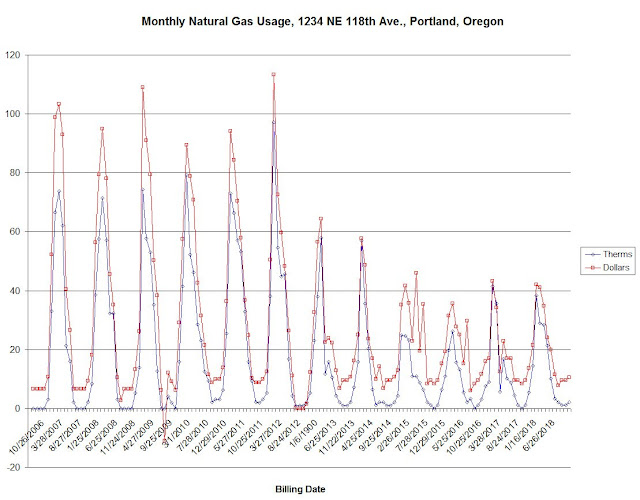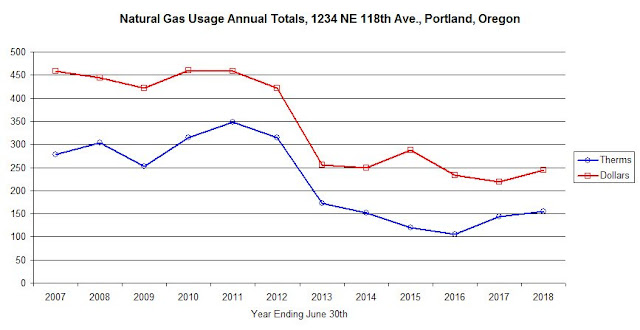How does my home weatherization measure up in "carbon" significance, for natural gas heating and clothes drying. ? Here is a chart for natural gas usage, totals through September 2018 tracking, for years ending June 30th:
Annual totals are a better display of weatherization achievements. Reduction of natural gas usage by more than half is evident, and is sustained. Say my current annual usage of natural gas is 140 therms.
There are 0.00548 metric tonnes of CO2 per 1 therm of natural gas . (Source: U.S. Department of Energy)
Multiply therms by 0.00548, to compute tons, result now about 0.8 tons, and about double that before 2012. I reduce my carbon footprint by less than 10% in conserving natural gas heat, but it does matter, and is painless.
US avg.: In 2014, 67.2 million households used natural gas. Collectively, they used 5.1 billion cubic feet of natural gas annually, or 730.84 CCF (approximately 748.38 therms) per household or 283.27 CCF (approximately 290.07 therms) per person per household using natural gas. (Source: Energy Information Agency, US Census Bureau.)
My 300 therms per year, reduced by half, is consistent with these census numbers.
Look too at my electricity usage updated to end-September 2018, for "carbon" significance.
It seems that $30 per month at peak each year is what I expect to pay for electricity, based on long history. I regained control of my expenses in 2012, now at $30 per month average, after doubling of the cost of electricity. It is good that there is not cheap hydro power for us along the lower Columbia River, after all.
The simpler picture in yearly totals has its own story to tell, that 2012 conservation, persists. If current electricity consumption is 3000 KWH per year, that converts to carbon equivalent at 1.5 lb CO2 per KWH, 3000 KWH is 4500 pounds, 2.25 tons. This is nearly three times my footprint for natural gas for room heat and that thrown away in clothes drying. This is not welcome news. I want more justified pride in weatherization than in getting rid of an electric clothes dryer and eliminating all incandescent lighting. I am saving about $300 per year of natural gas, and $300 per year of electricity, by my responsible behavior, but the electricity conservation matters much more as carbon and impact on the Earth. These insights are not intuitive. Are you glad that I have shared them? Will someone please learn things with me, and talk with me via post comments? Or if errors are evident, please offer correction.
If anyone has the means, please join me or lead, in asking electric utilities to save and offer the simple set of monthly data to each customer, retaining without limit as history:
Reading date, Delta KWH, Billing Amount, Elapsed Days, Year (of years ending June 30th.)
Where billing data unavoidably reveals utility disincentives to save, with large base rates that distort inferred cents per KWH and dollars per therm, I see no justification or benefit in concealment.



